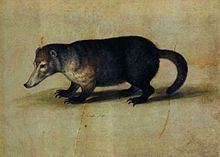Rank Genus | Phylum Chordata Scientific name Nasuella | |
 | ||
Similar Nasuella olivacea, Eastern lowland olingo, Bdeogale, Mammal, Black‑footed mongoose | ||
Mountain or dwarf coati nasuella olivacea recinto pensamiento c andes
Mountain coatis are two species of procyonid mammals from the genus Nasuella. Unlike the larger coatis from the genus Nasua, mountain coatis only weigh 1–1.5 kilograms (2.2–3.3 lb) and are endemic to the north Andean highlands in South America. Until recently only a single species with three subspecies was recognized. In 2009 this species was split into two species, the eastern mountain coati (N. meridensis) from Venezuela, and the western mountain coati (N. olivacea, with subspecies quitensis) from Colombia and Ecuador.
A population discovered in southern Peru (more than 1,000 km or 620 mi south of the previous distribution limit) has tentatively been identified as the western mountain coati, but may represent an undescribed taxon.
Externally, the two species of mountain coatis are quite similar, but the eastern mountain coati is overall smaller, somewhat shorter-tailed on average, has markedly smaller teeth, a paler olive-brown pelage, and usually a dark mid-dorsal stripe on the back (versus more rufescent or blackish, and usually without a dark mid-dorsal stripe in the western mountain coati). Both are found in cloud forest and páramo; at altitudes of 2,000–4,000 metres (6,600–13,100 ft) for the eastern mountain coati, and 1,300–4,250 metres (4,270–13,940 ft) for the western mountain coati.
They are very poorly known, and the "combined species" (when only one species was recognized) has been classified as data deficient by the IUCN. Their behavior largely appears to resemble that of the better-known Nasua coatis, although the mountain coatis feed less on fruit. Unlike the Nasua coatis, mountain coatis are very rare in captivity. Among ISIS registered institutions, only three zoos (all in the USA) reported that they had mountain coatis in early 2011, but at least one of these appears to be a case of misidentification. A mountain coati that was confiscated from poachers is kept at Bioparque la Reserva in Cota.
Genetic evidence indicates that the genus Nasua is only monophyletic if it also includes the mountain coatis. Based on cytochrome b sequences, Nasua nasua is the sister taxon to a clade consisting of Nasua narica plus both species of Nasuella.
